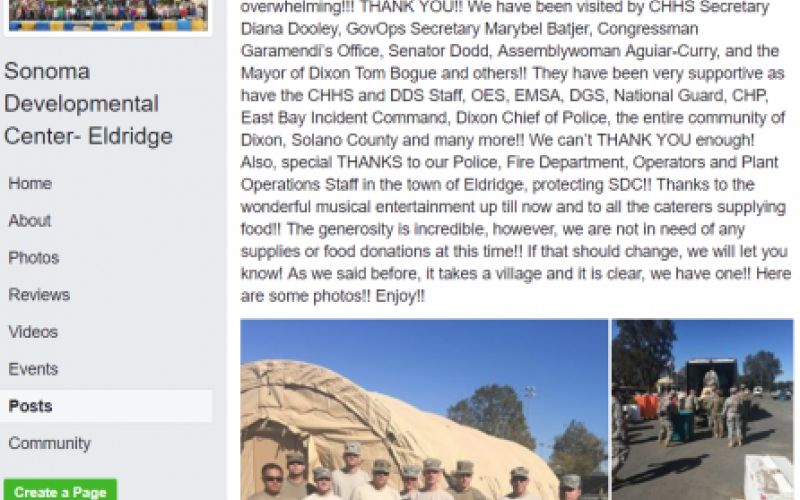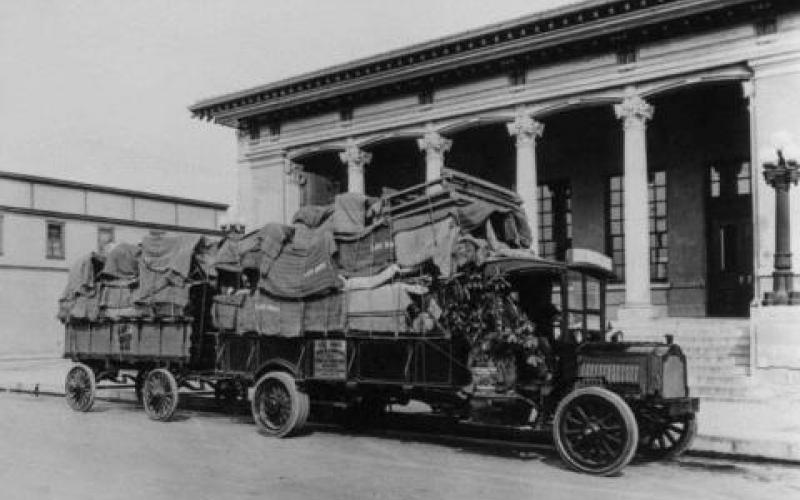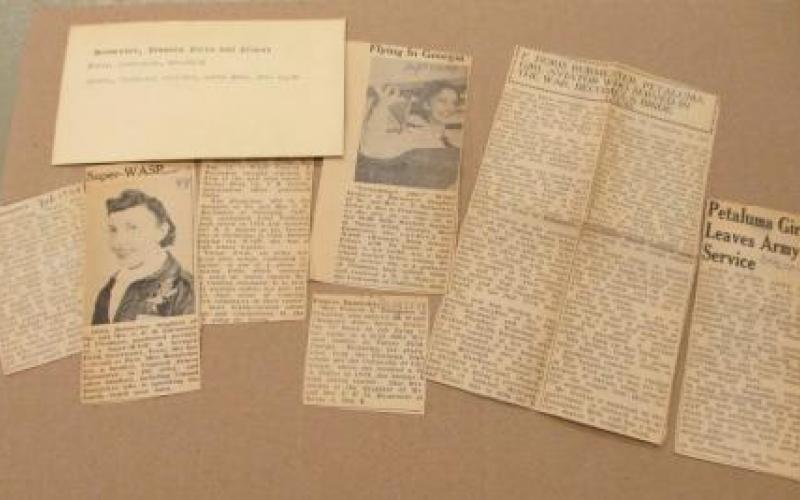Local History and Genealogy Notes
Web Archives: A Step into Libraries of the Future
Posted on October 20, 2018
For many people, libraries are where they go for the hottest “lucky day” books, or season five of The Americans, or to stream the latest Grammy winners. But public libraries are also where people go when they need one-of-a-kind resource materials such as a 1967 telephone book for the town of Geyserville or a copy of a hand-drawn diseño map of Rancho Petaluma.
Following the October 2017 wildfires, journalists and others came to Sonoma County History & Genealogy Library to learn about the historic development of Fountain Grove, Coffey Park and other areas affected by fire. They reviewed Board of Supervisors and Sonoma County Planning Commission minutes from the county archives to gain an understanding of past land use decisions. Newspaper clippings relating to the 1964 Hanly fire were also accessed. Pause for a moment and consider what the primary sources of the year 2018 will look like. What formats will they consist of? How should libraries be collecting and archiving these records?
As records of social life and community interaction increasingly live online, public libraries are recognizing the need to capture and preserve these digital traces as the primary sources for tomorrow's researchers. Following the 2017 fires, Sonoma County Library partnered with the Internet Archive to embark on just such an endeavor, joining 26 other public libraries in a grant-funded program called Community Webs. Sonoma County Library took the opportunity to build a web archive of websites, news, and social media content related to the fires – taking “snapshots” of the aftermath and recovery efforts as they were shared online. The North Bay Fires web archive documents the websites of the County of Sonoma and the City of Santa Rosa, including the communication of their recovery and resiliency services to the public. The archive also contains the websites of groups that formed out of the fires like Coffey Strong and UndocuFund, in addition to blog posts, Facebook posts and tweets reflecting a range of emotions from shock and anger to heartbrokenness and hope. The web archive supplements the oral histories, wildfire stories, artwork, poetry and prose, and artifacts gathered and exhibited by other local organizations – together revealing the many facets of lived experiences of the residents of Sonoma County.
Archive-It!
Follow this link to view the North Bay Fires 2017 web archive hosted by Archive It, a web archiving service offered through the Internet Archive, along with many other web archives of our recent past including collections on Katrina, Black Lives Matter, and global human rights. You can browse or search among collections by topic or collecting organization, or search within collections using tabs to access a list of “sites,” or perform a text level search for a particular word or phrase. Clicking on the title or URL of an entry will bring you to a calendar page showing the dates on which the URL was captured. Selecting a specific date will bring you into the Internet Archive’s Wayback machine to view the web content as it looked on that particular date.
Highlights of the collection include the Facebook page of the Sonoma Developmental Center, the Berkeley firefighters’ video, the Go Fund Me – Northern California fire relief webpage, the website of the Sonoma Ecology Center featuring time-lapse videos of vegetation regrowth, the Santa Rosa Fire Department’s Twitter page, and a Youtube video of the Sonoma County Day of Remembrance (October 28, 2017).
Web archiving technologies are in constant evolution, trying to keep pace with the dynamic Web. You may encounter missing content or broken links as you navigate the North Bay Fires web archive – that is the nature of trying to capture digital content from a variety of ever-changing structures and sites. Please be patient as we test these new tools. The challenging mechanics of web archiving, as well as the ethical issues it raises, make web archiving a ripe domain for more evaluation and research, which is occurring in projects such as Documenting the Now, an effort to collect and preserve digital content from Twitter while respecting the rights of content creators. Nevertheless, institutions like the Library of Congress are moving ahead in the domain of digital stewardship, recently releasing 4,240 new web archives across 43 event and thematic collections.
The October fires prompted this “pilot” project which the library can now assess as it considers expanding its collecting and archiving of online content. It’s really not a matter of whether public libraries should archive web content but rather how libraries can join with other local institutions and organizations to take collective responsibility for preserving the primary sources of the future.
For more information, contact Joanna Kolosov, jkolosov (at) sonomalibrary (dot) org
Sonoma County History and Genealogy Library Closes Temporarily
Posted on August 17, 2018
The Sonoma County History & Genealogy Library, a special collection of the Sonoma County Library system, which is dedicated to collecting and preserving local history as well genealogical materials of a national and international focus, will close temporarily starting August 27, 2018, as the building it occupies receives much-needed upgrades.
Starting September 4th, one-on-one reference service will be available at the Santa Rosa Central Library at 211 E Street, Monday through Saturday from 1 PM to 5 PM. Materials from the collection will be retrieved upon request.
Volunteers from the Sonoma County Genealogical Society will also be available to assist members of the public on Wednesdays and Fridays between 1 PM to 4 PM in the main Central Library reading area. Sign-ups at the Central reference desk encouraged.
When we return to the “Annex” it will be to freshly painted walls and ceilings, functional heating and air conditioning system, improved lighting, new microfilm readers and public computers; more data and electrical outlets, a slight reconfiguration of the reference desks and staff and processing areas and more!
For more information, contact Katherine J. Rinehart krinehart@sonomalibrary.org. Keep up with all library events on our website and Facebook
A Northern California "Pioneer" in Her Own Right
Posted on March 28, 2018
Noted in a recent talk by library manager Katherine Rinehart and historian John Sheehy on the Petaluma Ladies’ Improvement Club was an exemplar of early women journalists of Sonoma County, Anna Morrison Reed, the publisher and managing editor of the Sonoma County Independent (Petaluma) from 1909 to 1916. As we close out Women’s History Month, we would like to point the spotlight on a woman some have called a force of nature.
Anna Morrison Reed (1849-1921) was a lecturer, poet and magazine and newspaper editor from Ukiah and Petaluma. In her early twenties, she traveled throughout the counties of northern California, lecturing on temperance and women’s issues. In 1904, she founded the Northern Crown magazine to capture the beauty and challenges of life lived in rural northern California. Her first book of poetry, Earlier Poems of Anna M. Morrison, was published in 1880. Three other volumes followed with the final volume released in 1915.
Meanwhile
Above the sounds of strife and care
Confused and jangled everywhere,
I hear in tenderest refrain
The promise that you’d come again.
The soft winds blow across the world,
And sails are filled, and sails are furled;
A thousand suns arise and set,
Meanwhile—in May—I’m waiting yet.
Anna M. Reed, 1915 (Keller, 227)
Born in Dubuque, Iowa, 4-year-old Anna made the journey to California with her mother, Mary, in 1854 from New York by ship, crossing Central America through Nicaragua—the last 13 miles by donkey—and sailing on to San Francisco aboard the Sierra Nevada. They then made their way to Butte County, California, where her father had gone ahead to work in the mining industry. Mary joined her husband in frontier living, offering midwifery services to supplement the family income. With only a few months of formal schooling, young teen Anna began earning money teaching and writing articles for the local press. When her parents contracted malaria, she had to step in to support the family that had grown to six, taking on an intense lecture circuit for the next two-and-a-half years. During that time, she spoke to the small-town residents of every county in northern California except Modoc. Lecturing allowed her to save enough money to purchase a family house in her name for $250 in Timbuctoo, Yuba County. She called it “Dreamland Home.”
In 1872, she married John Smith Reed (1829-1900), a local Ukiah businessman and one of the founders of the Bank of Ukiah. At that time, Anna took a break from lecturing but was still very active in the local and state temperance movement. In 1889, a fire destroyed their Ukiah home and a large music hall built by Mr. Reed. The family retreated to their ranch in Laytonville, but John never fully recovered from his business losses and died a broken man on February 10, 1900. Anna continued to work to support her family, which now included five children. It was during this time that she became the first woman to deliver an annual address before the State Agricultural Society of California in Sacramento on September 14, 1893. She also was appointed by the California state legislature to the seven-member State Board of Lady Managers for the 1893 Columbian Exposition in Chicago. She traveled extensively throughout the northern counties, in some cases with a child in tow, to stir interest and raise money for the creation of exhibits that would showcase the unique bounty of her home state for a world audience.
In 1904, Anna again bought a house for her family. Her 1914 diary entry, written on the date of her final payment, is triumphant despite other expectations:
Feb. 2: Paid the last payment on my home in Ukiah—the Carl Purdy Place, $7,48.50, today. Also placed a homestead upon it. The first home that I have owned personally since I sold “Dreamland Home” at Timbuctoo, in Yuba County, that I bought in my girlhood, with money that I had earned lecturing and writing for the Press. I bought it from Judge Redfield, and sold it after my marriage. The $30,000 home to be given me, in my own name, after my marriage never materialized. Had my husband kept his promise to me, it would have been better for both and all concerned.
Anna actively campaigned for women’s suffrage beginning in 1904, the same year she published the first issue of the Northern Crown. She would be the managing editor for the next 16 years, tackling the progressive issues of her time—“women’s rights, including suffrage; the education of young children; organized labor; urban graft, along with the need for political reform; the environment, notably forest management; and temperance” (Thompson, 93). [Issues of the Northern Crown are available in hard copy at the Sonoma County History & Genealogy Library or online via the Internet Archive.] A fearless advocate for women, she spearheaded fundraising efforts for the Pioneer Mother Statue that debuted at the Panama Pacific Exposition in San Francisco in 1915. The statue stands today in Golden Gate Park as a testament to the perseverance of the early women pioneers of California, including her mother, Mary E. (Preston) Morrison.
California women won the right to vote in 1911. Anna Morrison Reed ran for the California State Assembly in the 6th district as a Democrat in 1918 (Check out Her Hat was in the Ring! for more examples of women who ran for political office before 1920). Although she did not win the race, she found other ways to make her voice heard and help steer her contemporaries toward the progressive ideas of her time. She died in San Francisco on May 23, 1921, having witnessed the passage of the 19th Amendment.
Pauline C. Thompson, the author of a master’s thesis (1993) on Anna Morrison Reed and herself a lifelong Occidental resident, paints a realistic picture of Reed as “a feminist, but not a radical feminist” (Thompson, xi)—a product of her times. No matter her work as lecturer, editor, or World’s Fair lady manager, “she always maintained that home and family were her most important concern” (Thompson, xi). Thompson, who drew extensively from Reed’s diaries for her research, acknowledges that her study of Anna Morrison Reed only captured one segment of the female population of California in the late 1880s to early 1900s—the majority white, middle-class. Nonetheless, she felt it a significant piece of California women’s history to tell: “That she was a remarkable woman, there is no doubt. There is also little doubt that she was a survivor and an opportunist, perhaps as much because of her frontier experiences as her own inner resources” (Thompson, xiii). Thompson’s thesis was accessed through a generous Interlibrary Loan from California State University East Bay. Sonoma County Library is looking to acquire its own copy.
Sources:
Keller, John E. (Ed.). (1978). Anna Morrison Reed. Lafayette, CA: John E. Keller.
Thompson, Pauline C. (1993). A ‘California girl’: the life and times of Anna Morrison Reed, 1849-1921 (Unpublished master’s thesis). California State University, Hayward.
Sarah Cassiday, the Ladies' Improvement Club and an Ambulance
Posted on February 18, 2018
On March 18, 2018, I'll be joining my friend John Sheehy at the Petaluma Museum. We will be presenting on the topic of the Petaluma Ladies' Improvement Club. The Club held their first meeting on May 28, 1896, at the offices of the "Petaluman" a weekly newspaper published by Rena Shattuck (1858-1942). Miss Shattuck, a syndicated columnist that wrote under the byline of Polly Larkin, was the principal promoter of the club. The first board of directors were Addie Atwater, president; Rena Shattuck, vice president; Kate Weston, secretary; Estelle Newburgh, corresponding secretary; and Zoe Fairbanks, treasurer. Within a year, thirty-one-year-old Sarah Cassiday, daughter of Samuel and Cynthia (Denman) Cassiday, would join the board first as secretary and later as treasurer.
My part of the presentation will focus on the activities of these women as well as their backgrounds and legacy. John will discuss the Petaluma Ladies' Improvement Club within the context of the American Women's Club movement.
Although I have not researched every member of the Club which operated through the teens, I've become familiar with many of the most active and find them to be fascinating. I am particularly drawn to Sarah Cassiday who served as Petaluma's head librarian from 1898 until her retirement in 1930. When Petaluma's Carnegie Library opened to the public in 1906, Miss Cassiday was there to manage its collection of just over ten thousand books and serve the needs of its patrons. By 1907 visitors to the library numbered in an excess of two thousand a month.
In addition to her full-time job at the library, Sarah gave a great deal of energy to activities associated with the Ladies' Improvement Club. For instance, in January of 1909, the Petaluma Argus reported that it was Miss Sarah Cassiday who was responsible for the idea of organizing a tag sale with proceeds going toward the purchase of an ambulance for the City of Petaluma. The article provides a wonderful sense of Miss Cassiday's personality, at least as understood by the reporter. The title of the article is "Saturday Was Tag Day" and was published on January 16, 1909.
Today was a tag day. Did you notice it? The yellow tags are very much in evidence on all sides, and if the Ladies' Improvement Club does not rake in a neat sum for that new ambulance, the Argus misses its guess.
Owing to the weather, it had been decided to postpone the tag day until later but through a misunderstanding some of the lieutenants began work and when this was ascertained by the leaders, the order went forth to go ahead with the good work.
Miss Sarah Cassiday, who originated the plan, had full charge and conducted the warfare from her headquarters at the Carnegie library. She had her plans well made and handled her little army with the skill of a natural born commander.
She had an able force of captains and they in turn commanded a big force of lieutenants. The city was well distracted and but few people escaped without contributing at least one dime to the good cause. At press time the ladies were well pleased with the result of the hour, but of course the total amount could not be learned. Everybody who was approached, contributed with good nature.
Some of the local merchants were very liberal and they were almost covered with the yellow tags. As a local remarked: "Nearly everybody had a streak of yellow about him on Saturday."
A later article stated that the tag sale raised $526. Whatever balance remained for the purchase price was made up from the Club's treasury.
Taking the lead on raising funds for an ambulance was just one of many ways in which Sarah Cassiday contributed to the betterment of her community as a member of the Petaluma Ladies' Improvement Club. To hear more about her and others, join us at the Petaluma Museum on March 18th at 4 PM. This presentation coincides with a Women’s History Month exhibit. For more information go to http://www.petalumamuseum.com/
News Clippings of Local WWII Servicemembers to be Digitized by California State Library
Posted on January 16, 2018
The Sonoma County Library is thrilled to announce approval of its nomination to California Revealed for a unique project. California Revealed is a State Library initiative to support California’s public libraries, in partnership with other local heritage groups, to digitize, preserve, and serve online historically significant California artifacts and culture.
Sonoma County Library Associate Joanna Kolosov nominated a “hidden” collection of newspaper clippings which feature Sonoma County women and Japanese Americans who served in the military during World War II. The collection comprises 74 multi-part records which represent a portion of a larger collection that is housed at the Sonoma County History & Genealogy Library but has not been cataloged. The Library is excited to have the opportunity to make these materials accessible to the public in a digital format.
The Sonoma County Library was one of 81 institutions to nominate over 11,000 items. The Library’s addition will be added to the California Revealed database, housed within the California State Library, made accessible through the Internet Archive and California Light & Sound, as well as on the Library’s Sonoma County Local History & Culture website.
Sonoma County Library’s local history and genealogy collection is a community resource of immense value located adjacent to the Central Santa Rosa Library in the Library’s Annex building. This historical collection includes more than 40,000 photographs, a comprehensive collection of Sonoma County historical works, county, family and property history, access to the Sonoma County Archives, Sonoma County History Index with thousands of references to county events, places and people, wide ranging newspaper clippings files, and more!
To learn more about the California Revealed project and the Sonoma County History & Genealogy Library, contact History & Genealogy (707) 308-3212 or history@sonomalibrary.org.






